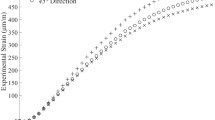Abstract
Background
Finite element models used for simulations of axisymmetric features within a material with “infinite” boundaries can get large and computationally burdensome because they typically require large meshes to simulate adequately the far boundary conditions. Previous work, using hole-drilling residual stress calibration coefficient calculations as an example, has described a method whereby an outer ring of higher stiffness material is placed around the region of interest to simulate the effect of the far-field material. However, the approach works only for isotropic stresses or for deviatoric stresses. This feature makes it unsuited to the analysis of high-level general stress states where non-linearities caused by plastic deformations preclude the use of superposition.
Objective
To develop a modeling procedure where quasi-infinite boundary conditions can be modeled for a general stress state.
Methods
Material stresses are modeled as fictitious thermal loads. The directional character of general stress is accommodated by reversing the common practice and using the temperature difference as the proportionality constant and the thermal expansion coefficients as the loading parameter.
Results
The proposed thermal loading procedure enables quasi-infinite boundary conditions to be simulated for general stress states. Example radial deformation calculations showed correspondence with theoretical expectations within 1% of their maximum values.
Conclusions
The proposed method was shown to be suitable for general stress states. This is particularly useful for analyses of high level residual stresses where non-linearities caused by plasticity preclude the use of superposition.




Similar content being viewed by others
References
Beer G, Watson JO (1989) Infinite Boundary Elements. Int J Numerical Methods Eng 28(6):1233–1247
Schajer GS, Whitehead PS (2018) Hole-Drilling Method for Measuring Residual Stress. Morgan & Claypool, Vermont, USA. 186
Grant PV, Lord JD, Whitehead PS (2002) The Measurement of Residual Stresses by the Incremental Hole Drilling Technique. Measurement Good Practice Guide No.53, National Physical Laboratory, Teddington, UK
Ajovalasit A, Scafidi M, Zuccarello B, Beghini M, Bertini L, Santus C, Valentini E, Benincasa A, Bertelli L (2010) The Hole-drilling Strain Gauge Method for the Measurement of Uniform or Non-Uniform Residual Stresses." AIAS–TR01:2010, Associazione Italiana per l'Analisi delle Sollecitazione, Rome, Italy, 70.https://doi.org/10.5772/intechopen.90392
ASTM (2020) Determining Residual Stresses by the Hole-Drilling Strain-Gage Method. Standard Test Method E837-20. American Society for Testing and Materials, West Conshohocken, PA
Rendler NJ, Vigness I (1966) Hole-drilling Strain-gage Method of Measuring Residual Stresses. Exp Mech 6(12):577–586. https://doi.org/10.1007/BF02326825
Steinzig M, Ponslet E (2003) Residual Stress Measurement Using the Hole Drilling Method and Laser Speckle Interferometry: Part I. Exp Tech 27(3):43–46. https://doi.org/10.1111/j.1747-1567.2003.tb00114.x
Nelson DV, Makino A, Schmidt T (2006) Residual Stress Determination Using Hole Drilling and 3D Image Correlation. Exp Mech 46(1):31–38. https://doi.org/10.1007/s11340-006-5859-0
Beghini M, Bertini L (2000) Analytical Expressions of the Influence Functions for Accuracy and Versatility Improvement in the Hole Drilling Method. J Strain Anal 35(2):125–135. https://doi.org/10.1243/0309324001514071
Blödorn R, Bonomo LA, Viotti MR, Schroeter RB, Albertazzi A (2017) Calibration Coefficients Determination Through Fem Simulations for the Hole-Drilling Method Considering the Real Hole Geometry. Exp Tech 41(1):37–44. https://doi.org/10.1007/s11340-021-00719-4
Held E, Gibmeier J (2015) Application of the Incremental Hole-Drilling Method on Thick Film Systems—An Approximate Evaluation Approach. Exp Mech 55(3):499–507. https://doi.org/10.1007/s11340-014-9962-3
Nau A, von Mirbach D, Scholtes B (2013) Improved Calibration Coefficients for the Hole-Drilling Method Considering the Influence of the Poisson Ratio. Exp Mech 53(8):1371–1381. https://doi.org/10.1007/s11340-013-9740-7
Schajer GS, To L (2022) Simulation of Infinite Boundaries When Evaluating Hole-Drilling Calibration Data. Exp Mech. https://doi.org/10.1007/s11340-022-00834-w
Baldi A (2017) Far-Field Boundary Conditions for Calculation of Hole Drilling Residual Stress Calibration Coefficients. Exp Mech 57(4):659–664. https://doi.org/10.1007/s11340-016-0235-1
Richards R (2000) Principles of Solid Mechanics. CRC Press, Boca Raton, FL
Beghini M, Bertini L (1998) Recent Advances in the Hole Drilling Method for Residual Stress Measurement. J Mater Eng Perform 7(2):163–172
Acknowledgements
The work was financially supported by the Natural Sciences and Engineering Research Council of Canada (NSERC).
Author information
Authors and Affiliations
Corresponding author
Ethics declarations
Conflict of Interest
The authors declare that they have no conflict of interest.
Additional information
Publisher's Note
Springer Nature remains neutral with regard to jurisdictional claims in published maps and institutional affiliations.
Gary S. Schajer is a member of SEM.
Rights and permissions
Springer Nature or its licensor (e.g. a society or other partner) holds exclusive rights to this article under a publishing agreement with the author(s) or other rightsholder(s); author self-archiving of the accepted manuscript version of this article is solely governed by the terms of such publishing agreement and applicable law.
About this article
Cite this article
Schajer, G.S., To, L. Simulation of Infinite Boundaries for Axisymmetric Finite Element Models. Exp Mech 63, 965–971 (2023). https://doi.org/10.1007/s11340-023-00963-w
Received:
Accepted:
Published:
Issue Date:
DOI: https://doi.org/10.1007/s11340-023-00963-w




